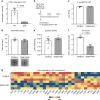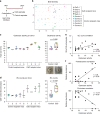Duodenal bacterial proteolytic activity determines sensitivity to dietary antigen through protease-activated receptor-2
- PMID: 30867416
- PMCID: PMC6416356
- DOI: 10.1038/s41467-019-09037-9
Duodenal bacterial proteolytic activity determines sensitivity to dietary antigen through protease-activated receptor-2
Abstract
Microbe-host interactions are generally homeostatic, but when dysfunctional, they can incite food sensitivities and chronic diseases. Celiac disease (CeD) is a food sensitivity characterized by a breakdown of oral tolerance to gluten proteins in genetically predisposed individuals, although the underlying mechanisms are incompletely understood. Here we show that duodenal biopsies from patients with active CeD have increased proteolytic activity against gluten substrates that correlates with increased Proteobacteria abundance, including Pseudomonas. Using Pseudomonas aeruginosa producing elastase as a model, we show gluten-independent, PAR-2 mediated upregulation of inflammatory pathways in C57BL/6 mice without villus blunting. In mice expressing CeD risk genes, P. aeruginosa elastase synergizes with gluten to induce more severe inflammation that is associated with moderate villus blunting. These results demonstrate that proteases expressed by opportunistic pathogens impact host immune responses that are relevant to the development of food sensitivities, independently of the trigger antigen.
Conflict of interest statement
The authors declare no competing interests.
Figures






Similar articles
-
Duodenal Bacteria From Patients With Celiac Disease and Healthy Subjects Distinctly Affect Gluten Breakdown and Immunogenicity.Gastroenterology. 2016 Oct;151(4):670-83. doi: 10.1053/j.gastro.2016.06.041. Epub 2016 Jun 30. Gastroenterology. 2016. PMID: 27373514
-
A human autoimmune organoid model reveals IL-7 function in coeliac disease.Nature. 2024 Aug;632(8024):401-410. doi: 10.1038/s41586-024-07716-2. Epub 2024 Jul 24. Nature. 2024. PMID: 39048815 Free PMC article.
-
Gluten-Dependent Activation of CD4+ T Cells by MHC Class II-Expressing Epithelium.Gastroenterology. 2024 Nov;167(6):1113-1128. doi: 10.1053/j.gastro.2024.07.008. Epub 2024 Aug 9. Gastroenterology. 2024. PMID: 39128638
-
A Clinician's Guide to Celiac Disease HLA Genetics.Am J Gastroenterol. 2019 Oct;114(10):1587-1592. doi: 10.14309/ajg.0000000000000310. Am J Gastroenterol. 2019. PMID: 31274511 Review.
-
How the Microbiota May Affect Celiac Disease and What We Can Do.Nutrients. 2024 Jun 14;16(12):1882. doi: 10.3390/nu16121882. Nutrients. 2024. PMID: 38931237 Free PMC article. Review.
Cited by
-
Celiac disease serology and gut microbiome following proton pump inhibitor treatment.Medicine (Baltimore). 2020 Aug 28;99(35):e21488. doi: 10.1097/MD.0000000000021488. Medicine (Baltimore). 2020. PMID: 32871870 Free PMC article. Clinical Trial.
-
Investigating the role of iron status in the development of coeliac disease: a Mendelian randomisation study.BMJ Open Gastroenterol. 2024 Jan 4;11(1):e001236. doi: 10.1136/bmjgast-2023-001236. BMJ Open Gastroenterol. 2024. PMID: 38177066 Free PMC article.
-
Microbiome Markers in Gastrointestinal Disorders: Inflammatory Bowel Disease, Colorectal Cancer, and Celiac Disease.Int J Mol Sci. 2025 May 17;26(10):4818. doi: 10.3390/ijms26104818. Int J Mol Sci. 2025. PMID: 40429958 Free PMC article. Review.
-
Microbiome of root vegetables-a source of gluten-degrading bacteria.Appl Microbiol Biotechnol. 2020 Oct;104(20):8871-8885. doi: 10.1007/s00253-020-10852-0. Epub 2020 Sep 2. Appl Microbiol Biotechnol. 2020. PMID: 32875365 Free PMC article.
-
T cell receptor cross-reactivity between gliadin and bacterial peptides in celiac disease.Nat Struct Mol Biol. 2020 Jan;27(1):49-61. doi: 10.1038/s41594-019-0353-4. Epub 2019 Dec 23. Nat Struct Mol Biol. 2020. PMID: 31873306
References
-
- Bustos D, et al. Colonic proteinases: increased activity in patients with ulcerative colitis. Medicina. 1998;58:262–264. - PubMed
Publication types
MeSH terms
Substances
Grants and funding
LinkOut - more resources
Full Text Sources
Other Literature Sources
Medical
Molecular Biology Databases

